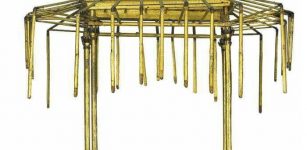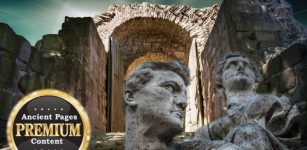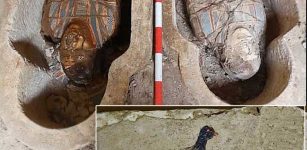Viking Children Were Buried With Extremely Sharp Knives – Afterlife Tools To Be Used In Valhalla?
Ellen Lloyd - AncientPages.com - Like many other ancient civilizations, Vikings had very several interesting burial customs.
Some Vikings' burial traditions are understood, but there are also certain aspects of the Norse culture we don’t yet fully comprehend.
Left: Credit: Imdb - Right: Gordito1869 - CC BY-SA 4.0
There is archaeological evidence Vikings used to bury their children with extremely large and sharp knives. The purpose of placing these artifacts in the tombs is not entirely clear, but one possibility is that the knives should help the little ones in their afterlife.
Nevertheless, this discovery is surprising to archaeologists, but it confirms the theory that the line between childhood and adulthood was very thin during the Viking Age.
The graves of the Viking children were found at Langeland and Lejre in Denmark. Scientists were able to determine the buried children are between 4 to 6-year-old and the graves are dated to the period from 800 to 1050 A.D. Examination of the artifacts discovered inside the tombs reveal the knives are made of steel and are very sharp. They seem almost too large to be used by small children, and yet they were placed there alongside these small bodies.
Life for ancient Viking children was different. Viking children did not have much time to enjoy their childhood. Work, learning, duties, and responsibility started at a very early age and there was not much time for playing games, but this does not mean it was boring to be a Viking child.
Based on the findings of these knives, researchers think that very young children used to walk around carrying a knife attached to their leather belts.
Associate Professor of Archaeology at the University of Copenhagen is convinced the knives were not toys, but tools. To the Vikings, the knife played an important part in daily life, and this also applied to the children. The knives in the children's graves also show that the knife has been something that followed people from childbirth and throughout life, says the archaeologist.
Unfortunately, our knowledge about Viking children is very limited because few child graves have been unearthed so far. Children are also not mentioned often in Norse Sagas.
Image credit: Michael Nielsen
One reason why we haven’t found many ancient graves containing children could be because only children from the upper Viking class received a proper burial.
Perhaps Vikings buried their children with knives because they thought it was an indispensable tool that one must carry when entering Valhalla. Located in Asgard, Valhalla was the home of the fallen Vikings who died in battle and the kingdom of the Norse god Odin.
Ancient Viking funeral traditions and rituals were very complex. Many relics in ancient tombs reveal that the type of burial a Viking received depended on his importance in society. Before the age of Christianity, when Vikings still worshipped pagan gods it was common to bury a Viking along with his belongings, often lying in a boat or a wagon to make the journey to the next world easier. People believed the deceased person would need certain objects in the afterlife.
Based on discovered archaeological evidence it seems that the funeral boat or wagon was a practice that was reserved for the wealthy.
Another option was that the Vikings were burned and cremation was rather common during the early Viking Age. Ashes were later spread over the waters. The vast majority of the major burial finds throughout the Viking world are cremations. Ship burial was reserved for great Viking warriors.
Over the years, researchers have also learned about some rather unusual Viking burial traditions. Did you for example know that Vikings burned and buried their longhouses?
Updated on June 22, 2022
Written by Ellen Lloyd – AncientPages.com
Copyright © AncientPages.com All rights reserved. This material may not be published, broadcast, rewritten or redistributed in whole or part without the express written permission of AncientPages.com
Expand for referencesScandinavian books and magazines
More From Ancient Pages
-
 Bacho Kiro Cave: Early Homo Sapiens Groups In Europe Faced Subarctic Climates
Archaeology | Sep 24, 2021
Bacho Kiro Cave: Early Homo Sapiens Groups In Europe Faced Subarctic Climates
Archaeology | Sep 24, 2021 -
 Findings From The First Temple Period Discovered In The City of David Corroborate A Biblical Event
Archaeology | May 4, 2024
Findings From The First Temple Period Discovered In The City of David Corroborate A Biblical Event
Archaeology | May 4, 2024 -
 Was Tutankhamun’s Chariot Equipped With Its Own Sunshade?
Archaeology | Jun 27, 2019
Was Tutankhamun’s Chariot Equipped With Its Own Sunshade?
Archaeology | Jun 27, 2019 -
 Ancient Cities Built By Biblical Giants – Archaeological Evidence
Ancient Mysteries | Jun 2, 2018
Ancient Cities Built By Biblical Giants – Archaeological Evidence
Ancient Mysteries | Jun 2, 2018 -
 Amazon Forest Communities Disappeared Long Before 1492 Arrival Of Europeans
Archaeology | Jun 19, 2019
Amazon Forest Communities Disappeared Long Before 1492 Arrival Of Europeans
Archaeology | Jun 19, 2019 -
 Remains Of An Ancient Seaport In Asini, Greece Discovered By Underwater Archaeologists
Archaeology | Mar 12, 2025
Remains Of An Ancient Seaport In Asini, Greece Discovered By Underwater Archaeologists
Archaeology | Mar 12, 2025 -
 New Cosmic Ray Bombardment Of The Great Pyramid – Search For The Hidden Chamber Continues
Archaeology | Jan 20, 2020
New Cosmic Ray Bombardment Of The Great Pyramid – Search For The Hidden Chamber Continues
Archaeology | Jan 20, 2020 -
 Trajan’s Market Was The World’s First Known Shopping Mall
Ancient History Facts | Jul 2, 2016
Trajan’s Market Was The World’s First Known Shopping Mall
Ancient History Facts | Jul 2, 2016 -
 Jolabokaflod – Iceland’s Wonderful Christmas Book Flood Tradition – Exchange Books As Christmas Eve Presents And Spend The Evening Reading
Christmas Traditions | Dec 25, 2024
Jolabokaflod – Iceland’s Wonderful Christmas Book Flood Tradition – Exchange Books As Christmas Eve Presents And Spend The Evening Reading
Christmas Traditions | Dec 25, 2024 -
 Last Homo Erectus Lived 117,000 Years Ago At Ngandong
Archaeology | Dec 19, 2019
Last Homo Erectus Lived 117,000 Years Ago At Ngandong
Archaeology | Dec 19, 2019 -
 Daily Life Of A Lady In Waiting – A Dangerous Profession Sometimes
Ancient History Facts | Aug 24, 2023
Daily Life Of A Lady In Waiting – A Dangerous Profession Sometimes
Ancient History Facts | Aug 24, 2023 -
 Lost Mayan City Hidden Deep In The Peten Jungle Discovered By Expedition Team
Archaeology | Mar 21, 2022
Lost Mayan City Hidden Deep In The Peten Jungle Discovered By Expedition Team
Archaeology | Mar 21, 2022 -
 Roman Empire’s Emerald Mines In The Egyptian Eastern Desert – New Evidence
Archaeology | Mar 2, 2022
Roman Empire’s Emerald Mines In The Egyptian Eastern Desert – New Evidence
Archaeology | Mar 2, 2022 -
 Dangerous Magnetic Anomaly And Unexplained Events In Mysterious And Dark Valley Trouble Scientists – Why Must The Stone Gate Not Be Crossed?
Featured Stories | Nov 7, 2024
Dangerous Magnetic Anomaly And Unexplained Events In Mysterious And Dark Valley Trouble Scientists – Why Must The Stone Gate Not Be Crossed?
Featured Stories | Nov 7, 2024 -
 Unexplained Phenomenon In East Anglia – Time Portal And Strange Glimpses From The Past – Part 1
Ancient Mysteries | May 31, 2018
Unexplained Phenomenon In East Anglia – Time Portal And Strange Glimpses From The Past – Part 1
Ancient Mysteries | May 31, 2018 -
 Amazing Discovery Of Ancient Roman Temple In The Netherlands Hailed As An Extraordinary Archaeological Find
Archaeology | Jun 20, 2022
Amazing Discovery Of Ancient Roman Temple In The Netherlands Hailed As An Extraordinary Archaeological Find
Archaeology | Jun 20, 2022 -
 Intriguing Ptolemaic And Roman Treasures Unearthed In Al Bahnasa, Egypt
Archaeology | Jan 10, 2024
Intriguing Ptolemaic And Roman Treasures Unearthed In Al Bahnasa, Egypt
Archaeology | Jan 10, 2024 -
 Incredible Shipwreck With Fascinating Cargo Found 1,200 Years After Sinking In Holy Land
Archaeology | Sep 22, 2022
Incredible Shipwreck With Fascinating Cargo Found 1,200 Years After Sinking In Holy Land
Archaeology | Sep 22, 2022 -
 Discovery Of An Unusually Large Ancient Artifact May Confirm Powerful Myth Of A Mysterious Race
Featured Stories | Oct 8, 2024
Discovery Of An Unusually Large Ancient Artifact May Confirm Powerful Myth Of A Mysterious Race
Featured Stories | Oct 8, 2024 -
 Sculptures Of Kybele, Athena, Hekate, Apollo Unearthed At Hellenistic Site Of Pisidia Antiocheia, Turkey
Archaeology | Oct 15, 2017
Sculptures Of Kybele, Athena, Hekate, Apollo Unearthed At Hellenistic Site Of Pisidia Antiocheia, Turkey
Archaeology | Oct 15, 2017



